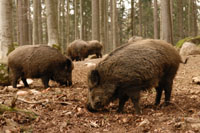Wild Boar and Woodland Regeneration

Despite their reputation for causing damage, it might be time to review the notoriety of the wild boar. The very thing that makes farmers and landowners in Kent and Sussex shudder, can also help regenerate woodland. Despite being a native of the British Isles, wild boar have not been seen in this country in any great number since medieval times, probably hunted out. James I and Charles I attempted to reintroduce to them to royal parks for hunting, but not with much success. By the late 17th century, they had cross-bred with domestic pigs to extinction. European wild boar were introduced for their meat in commercial farms in the Kent and East Sussex areas in the 1980s. There were the inevitable escapees, and these - breeding in the wild - became notorious for damaging farmland, and occasionally golf courses and even the odd football pitch!
However, it’s not all destruction. Natural woodland animals, wild pigs’ rooting behaviour breaks up and turns over the ground like a plough, aiding regeneration of trees and diversification of plants. In an experimental project (the Guisachan Wild Boar Project), wild boar were introduced to an area on the edge of Glen Affric, a remnant of the ancient Caledonian Forest. The aim was to see how successful they were in suppressing bracken that was shading out young pine saplings. Boar are particularly partial to bracken roots and will dig these up. Their rooting has pretty much the same effect as “brashing” or beating, the traditional but labour-intensive method of dealing with bracken. The experiment seems to have been a success - the number of pine saplings was significantly higher in the area with boar than in the control area. Above a certain density of population, however, there seem to be the same sort of problems you would expect with deer, that is, bark stripping from mature trees.
Athough legally classified as a “Dangerous Wild Animal”, they are actually very shy creatures and mostly nocturnal, so if you see one you are lucky.
Comments are closed for this post.
Discussion
in Sweden they are a plague. They can devastate a golf court, corn field, home garden etc. under a night.
Keep them under tight control.
Just played golf at burnham ans spotted wild bar in the bushes. Mike and artin (Swindon)
Here in America we have a big problem with the hog; better known here as the wild hog or ferall hog. estimated to be around 10 million nation wide. they are very destructive to everything. They destroy crops native wildlife,will eat just about anything. Most States have a year round open season on them.
They are getting faster on the run too.
I think there is still a project rearing ordinary pigs in woodland at Burnham Beeches; the conclusion is, I understand, that pigs are very good for woodland, among other things when hungry they dig up bramble roots and eat them. Much of the now-neglected woodland in the London area suffers from excess bramble – and presumably wild boar would have the same effect.
There is a boar research project going on in Sussex now – to see what effect, if any boar have on a woodland. You can read more on our blog
http://peplers.blogspot.com/2009/04/thermal-imaging-in-woods.html

Why is it that UK pig farmers are complaining so much about feeding pigs, pigs will eat almost any think given the chance, or the true real problem one of modern farming practices which just wants pigs to grow as fast as possible so they can slaughter quicker to make money.
We now farm pigs in the most cruel of ways on Frankenstein breeding farms,basically locking an animal in a steel prison pen, and is a shameful business that needs to be stopped, the best way is free range with all the benefits that brings.
Barry
10 October, 2022